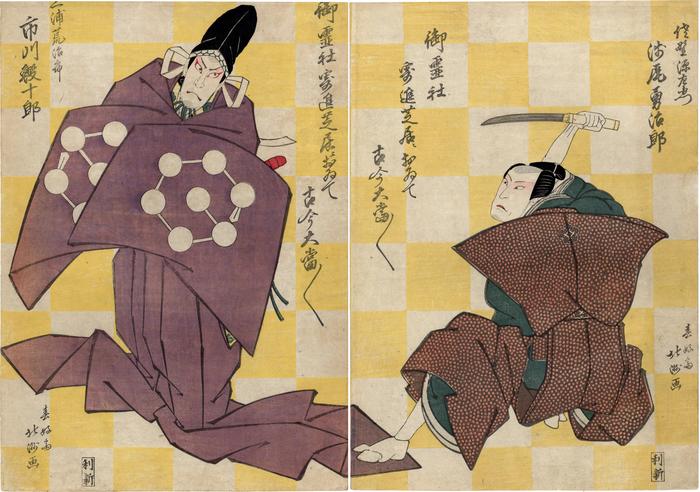Shunkōsai Hokushū (春好斎北洲) (artist ca 1808 – 1832)
Asao Yūjirō I (浅尾勇次郎) as Sano Genzaemon (佐野源左衛門) on the right and Ichikawa Ebijūrō I (市川鰕十郎) as Miura Arajirō (三浦荒次郎) in the play Keisei Sano no Funabashi (傾城佐野の船橋)
05/1822
10 in x 13.75 in (Overall dimensions) Japanese color woodblock print
Signed: Shunkōsai Hokushū ga
春好斎北洲画
Publisher: Toshikuraya Shinbei (Marks 539 - seal 25-553)
Rijksmuseum
The National Museum of Asian Art - left panel only
Philadelphia Museum of Art
Hankyu Culture Foundation - right panel
Hankyu Culture Foundation - left panel
Náprstek Museum - left panel only
Metropolitan Museum of Art At OsakaPrints.com they said: "Keisei Sano no Funabashi was one of Osaka kabuki's adaptations of an Edo ningyô jôruri (puppet play) titled Yûshoku Kamakurayama (1789). Based on actual events from 1784 involving an administrator named Tanuma Okitsugu and the killing of his son Okitomo by a bannerman samurai (hatamoto) named Sano Zenzaemon. The playwright was compelled — due to censorship against portraying current events involving the shogunate — to transplant the story back in time (he decided on the twelfth century), where he has Miura Arajirô and his father Yasamura foiled in an assassination plot. When Arajirô insults Genzaemon at a temple ceremony, Genzaemon slays him inside the Shogun's palace, a grievous offense leading to Genzaemon's ritual suicide (seppuku)."
****
"In 1784, Sano Zenzaemon, a minor hatamoto (or feudal lord), killed the son of Tanuma Okitsugu, the despised chancellor of the shogun, under severe provocation. This act broke Tanuma's power, and the grateful populace practically deified Sano, who was allowed an honorable death by his own hand. In the play based on this incident, Sano Genzaemon, (the hatamoto's stage name offers a corrupt official, Miura Arajirō, the honor of shooting down a crane in the presence of the shogun to recover a precious family genealogy in Miura's possession. Miura, however, repays this gesture by insulting Sano, who is shown here on the point of killing him.
From the Muromachi period on, there was a tradition of performing plays in shrine and temple compounds. In the seventeenth century the government restricted theater performances in Osaka, Kyoto, and Edo to the entertainment district of each city, but on occasion permitted temporary stages to be erected in shrine and temple precincts. These theaters were called miyachi shibai and, in Osaka, were located in Kitanoschinchi, Tenma, North Horie, Zama, and Goryō. Aside from a brief interruption in the 1840s, such performances were given throughout the Edo period, and many of them are commemorated in prints. An inscription on each panel of this print states that it was a fund-raising performance at the Goryō Shrine Theater and an unparalleled success. The play was considered appropriate to a fund-raising performance because the name of the play contains the name of the Funaba Shrine where the performance took place. Ōban diptychs with patterned yellow ground were common during this period in Edo and Osaka."
Quoted from: The Theatrical World of Osaka Prints by Roger Keyes, p. 90.
****
The text on both panels reads:
御霊社寄進芝居ニおゐて 古今大当/\
****
Illustrated:
1) In black and white on page 41 and in color on page 32 in Stars from the stage in Osaka by Matthi Forrer, Society for Japanese Arts, 1994, p. 41, #21. The left panel only. Forrer wrote: "The right-hand sheet features the hero of the play, Sano Genzaemon, impersonated by Asao Yūjirō, a dagger in his hand about to kill Miura. Although the name of Yūjirō is given on that print, Kabuki nenpyō correctly indicates the name of Gakūjirō, taken by the actor from the first month of that year (Kabuki jinmei jiten, 310)."
"The performance at the temple compounds - permitted on special occasions only (see Keyes, 90) - was for fundraising purposes, as corroborated in the inscription to the right, reading 'At the theatre of the Goryō Shrine for a donation: as always a great success' (Goryōsha kisin shibai ni oite kokin ōatari ōatari)."
2) in color in Ikeda Bunko, Kamigata yakusha-e shūsei (Collected Kamigata Actor Prints), vol. 1, Ikeda Bunko Library, Osaka 1997, page 47, no. 126.
3) in black and white in The Theatrical World of Osaka Prints by Roger Keyes, Philadelphia Museum of Art, 1973, page 91, no. 25.
4) in color in Osaka Prints by Dean J. Schwaab, 1989 Rizzoli, plate 53, page 91.
5) in a small black and white reproduction in Masterful Illusions: Japanese Prints in the Anne van Biema Collection, University of Washington Press, 2002, page 344. The left-hand panel only.
****
In an exhibition at the Metropolitan Museum of Art, 'Kyoto: Capital of Artistic Imagination', expected to run from July 24, 2019 to September 20, 2020, is the Met's copy of their print shown on the right.
Toshikuraya Shinbei (利倉屋新兵衛) (publisher)
Jitsukawa Gakujūrō I (初代実川額十郎) (actor)
Ichikawa Ebijūrō I (初代市川鰕十郎 9/1815 to 7/1827) (actor)
Kyōto-Osaka prints (kamigata-e - 上方絵) (genre)
actor prints (yakusha-e - 役者絵) (genre)
Asao Yūjirō I (初代浅尾勇次郎) (actor)
